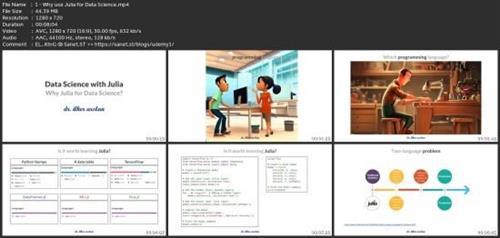Data Science With Julia (Part I)

What you'll learn
Having a strong grasp of data frames in Julia
Importing data with Julia
Analyzing and manipulating data with Julia
Data visualization with Julia
Requirements
I did my best to make this course self-contained, but still I strongly recommend studying the basics of Julia before enrolling. You can take my 'Programming with Julia' course or explore any other online training or book that suits your preferences.
Description
Do you want to learn data analysis, data science, machine learning, deep learning, and AI, but you are not sure about the programming language to choose? Or perhaps you are using Python and R, but you are tired of their slow performance.You can accomplish everything, and even more, with Julia compared to what you can do with Python or R, all with the same level of ease. Moreover, Julia offers significantly greater speed than both of them.Julia is a modern programming language developed for data science, machine learning, AI, and numerical computing. It is a dynamically typed language that is easy to learn and use and moreover has the speed of C.Julia combines the best features of dynamic languages like Python and R with low-level languages like C, C#, and Java. You can develop a machine learning model or an algorithm in Julia and use that code in a production environment. You don't have to use different languages for development and production.This is my second course about Julia. In this course, you will learn how to accomplish essential data science tasks with Julia: importing, analyzing, manipulating, and visualizing data. Having these foundations you will be ready for machine learning and deep learning with Julia which will be in my upcoming lectures. Please stay tuned.
Overview
Section 1: Introduction
Lecture 1 Why use Julia for Data Science?
Lecture 2 Two-Language Problem
Lecture 3 Julia is Fast: Why Does it Matter?
Lecture 4 Is Julia Really Fast?
Lecture 5 Julia Data Ecosystem
Lecture 6 Codes and Resources
Section 2: Working with Data Frames
Lecture 7 Creating Data Frames
Lecture 8 Indexing and Slicing Data Frames
Lecture 9 Conditional Filtering
Lecture 10 Selecting and Transforming Columns I
Lecture 11 Selecting and Transforming Columns II
Lecture 12 Summarizing Data with Split Apply Combine Strategy
Lecture 13 Joining Data Frames
Lecture 14 DataFrames: Additional Resources
Section 3: Importing Data
Lecture 15 Introduction
Lecture 16 Flat Files
Lecture 17 Delimited Files
Lecture 18 Spreadsheets
Lecture 19 HDF5 Files
Lecture 20 JSON Files
Lecture 21 XML Files
Lecture 22 Relational Databases
Lecture 23 Statistical Programs
Lecture 24 Web Scraping
Section 4: Data Analysis & Manipulation
Lecture 25 Introduction
Lecture 26 Project Description
Lecture 27 Import Project Data
Lecture 28 Remove Duplicates
Lecture 29 Merge Input & Output Data
Lecture 30 Summarize Data
Lecture 31 Nonnumerical Data
Lecture 32 Missing Data
Lecture 33 Outliers
Lecture 34 Standardization & Scaling
Lecture 35 Correlation Analysis
Lecture 36 Creating Categorical Variables from Numbers (Optional)
Section 5: Data Visualization
Lecture 37 Introduction
Lecture 38 Preparing Data
Lecture 39 Line Plot
Lecture 40 Scatter Plot
Lecture 41 Bar Plot
Lecture 42 Histogram
Lecture 43 Box, Dot, Violin Plots
Lecture 44 Three Dimensional Plots
Lecture 45 Interactive Statsplot
Lecture 46 Makie Package
Lecture 47 Dashboards with Makie
Lecture 48 Observables
Lecture 49 Interactive Dashboards with Makie
You may be an adept data scientist well-versed in Python or R, or you might be embarking on your learning journey, grappling with the choice of a programming language. I will try to convince you that, you can accomplish everything, and even more, with Julia compared to what you can do with Python or R, all with the same level of ease. Moreover, Julia offers significantly greater speed than both of them.

rapidgator.net:
nitroflare.com:

Published 4/2024
MP4 | Video: h264, 1280x720 | Audio: AAC, 44.1 KHz
Language: English | Size: 2.00 GB | Duration: 5h 6m
Best programming language for data analysis, data science and machine learning
MP4 | Video: h264, 1280x720 | Audio: AAC, 44.1 KHz
Language: English | Size: 2.00 GB | Duration: 5h 6m
Best programming language for data analysis, data science and machine learning
What you'll learn
Having a strong grasp of data frames in Julia
Importing data with Julia
Analyzing and manipulating data with Julia
Data visualization with Julia
Requirements
I did my best to make this course self-contained, but still I strongly recommend studying the basics of Julia before enrolling. You can take my 'Programming with Julia' course or explore any other online training or book that suits your preferences.
Description
Do you want to learn data analysis, data science, machine learning, deep learning, and AI, but you are not sure about the programming language to choose? Or perhaps you are using Python and R, but you are tired of their slow performance.You can accomplish everything, and even more, with Julia compared to what you can do with Python or R, all with the same level of ease. Moreover, Julia offers significantly greater speed than both of them.Julia is a modern programming language developed for data science, machine learning, AI, and numerical computing. It is a dynamically typed language that is easy to learn and use and moreover has the speed of C.Julia combines the best features of dynamic languages like Python and R with low-level languages like C, C#, and Java. You can develop a machine learning model or an algorithm in Julia and use that code in a production environment. You don't have to use different languages for development and production.This is my second course about Julia. In this course, you will learn how to accomplish essential data science tasks with Julia: importing, analyzing, manipulating, and visualizing data. Having these foundations you will be ready for machine learning and deep learning with Julia which will be in my upcoming lectures. Please stay tuned.
Overview
Section 1: Introduction
Lecture 1 Why use Julia for Data Science?
Lecture 2 Two-Language Problem
Lecture 3 Julia is Fast: Why Does it Matter?
Lecture 4 Is Julia Really Fast?
Lecture 5 Julia Data Ecosystem
Lecture 6 Codes and Resources
Section 2: Working with Data Frames
Lecture 7 Creating Data Frames
Lecture 8 Indexing and Slicing Data Frames
Lecture 9 Conditional Filtering
Lecture 10 Selecting and Transforming Columns I
Lecture 11 Selecting and Transforming Columns II
Lecture 12 Summarizing Data with Split Apply Combine Strategy
Lecture 13 Joining Data Frames
Lecture 14 DataFrames: Additional Resources
Section 3: Importing Data
Lecture 15 Introduction
Lecture 16 Flat Files
Lecture 17 Delimited Files
Lecture 18 Spreadsheets
Lecture 19 HDF5 Files
Lecture 20 JSON Files
Lecture 21 XML Files
Lecture 22 Relational Databases
Lecture 23 Statistical Programs
Lecture 24 Web Scraping
Section 4: Data Analysis & Manipulation
Lecture 25 Introduction
Lecture 26 Project Description
Lecture 27 Import Project Data
Lecture 28 Remove Duplicates
Lecture 29 Merge Input & Output Data
Lecture 30 Summarize Data
Lecture 31 Nonnumerical Data
Lecture 32 Missing Data
Lecture 33 Outliers
Lecture 34 Standardization & Scaling
Lecture 35 Correlation Analysis
Lecture 36 Creating Categorical Variables from Numbers (Optional)
Section 5: Data Visualization
Lecture 37 Introduction
Lecture 38 Preparing Data
Lecture 39 Line Plot
Lecture 40 Scatter Plot
Lecture 41 Bar Plot
Lecture 42 Histogram
Lecture 43 Box, Dot, Violin Plots
Lecture 44 Three Dimensional Plots
Lecture 45 Interactive Statsplot
Lecture 46 Makie Package
Lecture 47 Dashboards with Makie
Lecture 48 Observables
Lecture 49 Interactive Dashboards with Makie
You may be an adept data scientist well-versed in Python or R, or you might be embarking on your learning journey, grappling with the choice of a programming language. I will try to convince you that, you can accomplish everything, and even more, with Julia compared to what you can do with Python or R, all with the same level of ease. Moreover, Julia offers significantly greater speed than both of them.
Screenshots

rapidgator.net:
nitroflare.com:







